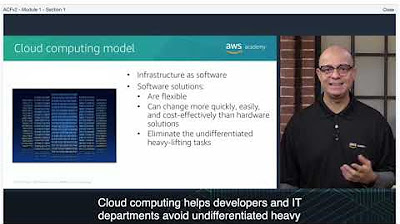M1.L6. Cloud Computing
Summary
TLDRThis course delves into cloud computing, contrasting it with traditional computing methods. It outlines the benefits of cloud computing, such as scalability, cost reduction, and improved security, and discusses its applications in business and personal use. The video covers various cloud architectures like IaaS, PaaS, and SaaS, and highlights the role of cloud service providers like Microsoft Azure, Amazon Web Services, and IBM Cloud. It also touches on the importance of cloud computing in modern business operations and personal productivity.
Takeaways
- 🌟 Cloud computing is the delivery of computing services, including servers, storage, databases, networking, software, analytics, and intelligence, over the Internet to offer faster innovation, flexible resources, and economies of scale.
- 🔍 The shift from traditional computing to cloud computing is significant, with 90% of companies using cloud services, indicating a major trend in the industry.
- 💾 Traditional computing relies on physical devices and on-site storage, which can be expensive and less flexible compared to cloud computing.
- 🌐 Cloud computing offers benefits like scalability, cost reduction, better business continuity, and enhanced collaboration efficiency.
- 🔒 Security is a key concern in cloud computing, as data is managed by external parties, raising issues of data privacy and the need for robust security measures.
- 🏢 Businesses use cloud computing for complex processes like business intelligence, data warehousing, and backups, often requiring substantial infrastructure and resources.
- 🏠 Personal use of cloud computing is generally simpler, with services like Google Suite and OneDrive providing easy access to storage and software applications.
- 🛠️ Cloud computing architectures include Infrastructure as a Service (IaaS), Platform as a Service (PaaS), and Software as a Service (SaaS), each offering different levels of management and control.
- 🌐 The architecture of cloud computing typically involves end users connecting to the cloud platform via the internet to access various services provided by the cloud provider.
- 🌐 Cloud service providers like Microsoft Azure, Amazon Web Services, and IBM Cloud offer a range of cloud-based solutions, catering to different business and personal needs.
Q & A
What is the definition of cloud computing?
-Cloud computing is the distribution of computing resources over the internet, which often includes hardware and software. It allows users to access storage and software packages online without the need for physical hardware or software installation.
How does cloud computing differ from traditional computing?
-Traditional computing involves using physical devices like laptops and installing software directly onto them. In contrast, cloud computing allows for storage and software access over the internet, managed by external parties, and is more scalable and cost-effective.
What are the advantages of cloud computing over traditional computing?
-Cloud computing offers advantages such as scalability, better business continuity, collaboration efficiency, and reduced costs since the maintenance and infrastructure management are handled by external providers.
What are some of the disadvantages of cloud computing?
-Disadvantages of cloud computing include network dependency, meaning an internet connection is required to access resources; pay-to-scale, where additional services come at extra costs; loss of control, as data and resources are managed by external providers; and security concerns over data privacy.
What is Infrastructure as a Service (IaaS) in cloud computing?
-Infrastructure as a Service (IaaS) is a type of cloud computing service where organizations can rent out infrastructure from cloud providers, such as storage and networking capabilities, without having to manage the physical hardware themselves.
Can you explain Software as a Service (SaaS) in the context of cloud computing?
-Software as a Service (SaaS) is a cloud computing approach where software applications are delivered over the internet. Users access these applications through a browser without installing them on their local devices, with examples including Google Docs and Microsoft Office 365.
What is Platform as a Service (PaaS) and how does it benefit organizations?
-Platform as a Service (PaaS) provides a platform for developers to build, test, and deploy applications in the cloud. It benefits organizations by eliminating the need to invest in on-premise infrastructure and software licenses, allowing them to focus on development and innovation.
How is cloud computing used in business applications?
-Cloud computing is used in business for applications such as business intelligence, data warehousing, and backups. It allows businesses to scale their infrastructure and storage needs, access powerful analytics tools, and maintain data backups without managing physical servers.
What are some personal use cases of cloud computing?
-Personal use cases of cloud computing include using Google Suite for productivity tools like Google Docs and Google Sheets, and using OneDrive for storage and access to Microsoft Office online. These services offer convenience and accessibility without the need for local installation.
What are some popular cloud service providers mentioned in the script?
-Some popular cloud service providers mentioned are Microsoft Azure, Amazon Web Services (AWS), and IBM Cloud. Each offers various cloud computing services, including IaaS, PaaS, and SaaS, catering to different organizational and personal needs.
How does cloud computing support business growth and scalability?
-Cloud computing supports business growth and scalability by providing on-demand access to resources, allowing businesses to scale up or down as needed without significant upfront investments in infrastructure. This flexibility enables businesses to adapt quickly to changing market conditions and customer demands.
Outlines

This section is available to paid users only. Please upgrade to access this part.
Upgrade NowMindmap

This section is available to paid users only. Please upgrade to access this part.
Upgrade NowKeywords

This section is available to paid users only. Please upgrade to access this part.
Upgrade NowHighlights

This section is available to paid users only. Please upgrade to access this part.
Upgrade NowTranscripts

This section is available to paid users only. Please upgrade to access this part.
Upgrade Now5.0 / 5 (0 votes)





